#avgeekschoolofknowledge
Explore tagged Tumblr posts
Photo
Insert Random Comments

Someone asked me if “Fighting to be Heard” covers the BAe-146 fire tankers. Yes, Brian does cover that subject in his wonderful book on the BAe-146.
The two upper images in this post are from Neptune Aviation’s hot retardant loading training manual- how to load phos-check fire retardant while the engines are still running. This allows faster turn around times at tanker bases during fire missions. On the upper left of the image shows the danger areas around the BAe-146 when the engines are running.
The retardant loading ports on Neptune’s 146s are just under and aft of the aft passenger exists. It makes use of existing service panels- in this case, the former lavatory servicing panels. There is a loading port on each side. The overflow vents are just aft of the main landing gear doors. Neptune’s jets carry 3000 gallons of fire retardant.
The lower half of the image is the full page spread showing the 146 fire tankers from “Fighting to be Heard: How the British Aerospace 146 Started the Regional Jet Revolution”.
You know you want this book. It will push every avgeek button you have and probably some new ones you didn’t *know* you have. And I will talk my ass off about this book until every copy is in an avgeek’s hands.
Hard core? You bet. Just as hard core as some of the people who have this book already. One guy even reads pages of the book to his kids as bedtime stories. Gotta nurture the next generation of avgeeks, folks.
www.lajeteepress.com
#avgeek #aviation #aircraft #planeporn #LaJeteePress #BritishAerospace #BAe #BAe146 #Neptune
#instaaviation #aviationlovers #flight
#AvGeekSchoolofKnowledge #AvGeekNation #TeamAvGeek https://www.instagram.com/p/Ce7mgAZrwK5/?igshid=NGJjMDIxMWI=
#avgeek#aviation#aircraft#planeporn#lajeteepress#britishaerospace#bae#bae146#neptune#instaaviation#aviationlovers#flight#avgeekschoolofknowledge#avgeeknation#teamavgeek
3 notes
·
View notes
Photo
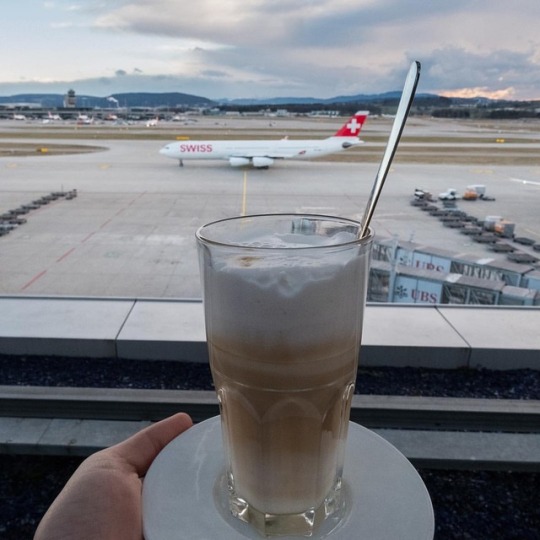
Кофе и самолёты . . . . #Aviation #Airplanes #PlaneLovers #AvGeek #AviationGeek #AvGeekSchoolofKnowledge #AirplanesYo #InstagramAviation @megaplane @zurichairport #swiss #inlovewithswitzerland @myswitzerland (at Zürich Airport)
#airplanes#instagramaviation#avgeekschoolofknowledge#planelovers#avgeek#airplanesyo#aviation#swiss#aviationgeek#inlovewithswitzerland
0 notes
Text
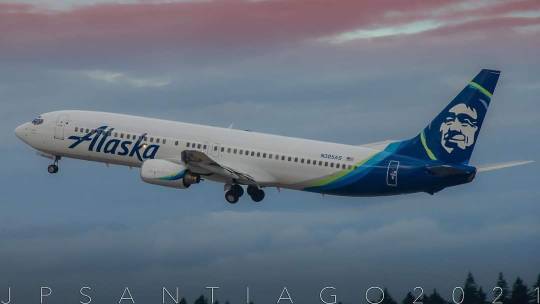
Here's a rare bird these days- a non-winglet equipped Boeing 737-900. Not a -900ER, but a straight -900, of which only 52 or so were built before being replaced by the more capable 737-900ER. Alaska Airlines has 12 737-900s in its fleet compared to 76 active 737-900ERs (3 parked as of 4Q2021).
This particular aircraft departing Sea-Tac early in the morning is N305AS, one of the three former prototype aircraft used in the 737-900 flight test program- all three are now operated by Alaska- N302AS, N303AS and N305AS and were the first three -900s built.
The lack of winglets is due to having an earlier style of wing structure that would make retrofitting winglets a lower return on investment compared to the early 900ERs that were retrofitted with winglets.
In Alaska's fleet, the -900s are still very useful on routes where range is not as critical- primarily non-transcon trunk routes and up and down the West Coast.
The 737-900 had its origins as an aircraft with the 737-800's capacity but with more leg room. In a two-class configuration, the limitations of the -900 were mininal but for the European inclusive tour operators flying single class configurations, the -900 was limited by the emergency exits. Additionally, in the wake of the 2003 Air Midwest crash in Charlotte, the standard passenger weight was revised for weight and balance purposes (170 in the summer, 175 in the winter, to 190 in the summer, 195 in the winter) which had the effect of shortening the range of all passenger aircraft.
For Alaska, this meant the -900 couldn't do transcons with a full load and the 737-800 was ordered to fill that role until the arrival of the 737-900ER with featured a beefed up structure and modifications to the wing and flap scheduling to improve its field performance (the first big change to the 737NG wing).
#Boeing #737 #Alaska #AlaskaAirlines #N305AS
#instagramaviation #splendid_transport #instaaviation #aviationlovers #aviationphotography #flight
#AvGeeksAero #AvgeekSchoolofKnowledge #AvGeekNation
1 note
·
View note
Photo

In the late-1950s, surplus B-17 Flying Fortresses used in the air-sea rescue role found their way into the hands of civilian fire bomber operations that offered a quantum leap in performance carrying significant loads of fire retardant. Prior to the arrival of the B-17s (and PB4Y-2s), no other civilian fire bomber in use approached the retardant capacity of the converted four-engined bombers. By 1960, the first of about two dozen B-17s were converted with bomb bay retardant tanks. Stripped of non-essential equipment, the B-17 offered a significant increase in power in the typical-high altitude areas that most forest fires were found. Most of the conversions flew on contracts with the US Forest Service. The fire bomber B-17s were retired in the late Sixties as aircraft like the Douglas DC-6 were converted for the role. In addition, the radial engines of the B-17s were increasingly difficult to support with spare parts. One enterprising outfit got around this issue by re-engining their B-17 with four Rolls-Royce Dart turboprops that once belonged to Vickers Viscount. As the Dart engines were much lighter than the Wright Cyclone radials, the nacelles had to be extended far forward to maintain the center of gravity with the spinners being nearly in line with the nose. Only one B-17, N1304N, was converted in 1970. Some sources indicate that the aircraft had the nickname "Batmobile" and she was so overpowered, that with both outboard engines shut down and feathered and carrying a full retardant load, she was still faster than a stock B-17. When the pilots made their drop, they had to shut down and feather the outboard engines to keep from overspeeding the airframe. This unique B-17 Flying Fortress was unfortunately lost in the same year it was converted. While fighting a fire near Dubois, WY, the engines lost power due to excessive ingestion of heated air and smoke from the fire and the aircraft failed to pull out of a retardant drop. #avgeek #aviation #aircraft #planeporn #Boeing #B17 #FlyingFortress #N1304N #RollsRoyce #Dart #turboprop #instagramaviation #instaaviation #aviationlovers #flight #AvGeeksAero #AvgeekSchoolofKnowledge #AvGeekNation https://www.instagram.com/p/CV9awDrt4Rl/?utm_medium=tumblr
#avgeek#aviation#aircraft#planeporn#boeing#b17#flyingfortress#n1304n#rollsroyce#dart#turboprop#instagramaviation#instaaviation#aviationlovers#flight#avgeeksaero#avgeekschoolofknowledge#avgeeknation
164 notes
·
View notes
Photo

Not all STOL airliner projects of the late 1960s and early 1970s were jets. In the late 1950s, Charles #Breguet worked on a four engine transport that not only utilized the propwash to "blow" the wing surface and its flaps, but had turboprop engines that were cross linked by a drive shaft to minimize impacts from engine failure. The ultimate development over a series of prototypes resulted in the #Breguet941. The increase in air travel in the 1960s meant that STOL airliners were one way of increasing airport capacity. Some airports even had STOL runways (LGA and DFW, for example). City center "STOLport" facilities were envisaged as helping offload airport traffic. McDonnell Aircraft obtained a license to market and build the aircraft for the US market as the McDonnell 188. Both #American #Airlines and #Eastern Air Lines tested the concept on a very limited basis particularly in the US Northeast corridor. The #McDonnell188 had four abreast seating with accommodation for 57 passengers using less than 1000 feet of runway to fly 500 miles. The fuselage was square section, so it was not pressurized. McDonnell did have plans for a pressurized version, the McDonnell 188E. The 188 was much smaller than the previous STOL airliner concepts I've posted, seating only 1/3 to 1/2 as many passengers as the previous designs I talked about. But it would have been ready for production before its jet STOL competitors. Passenger appeal wasn't great and the innovative cross shaft system added weight and maintenance complexity which in turn raised seat-mile costs. No orders resulted and the aircraft ended up with the French Air Force which withdrew them from use in 1974 due to the aircraft being maintenance intensive. Now I've got one more jet design and one more turboprop design to discuss, but keep in mind that these concepts were the focus of considerable effort by many companies at the same time the #BAe146 began development as the Hawker Siddeley HS.146. #avgeek #aviation #aircraft #planeporn #instaplane #McDonnellDouglas #instagramaviation #splendid_transport #instaaviation #aviationlovers #flight #AvgeekSchoolofKnowledge #AvGeekNation https://www.instagram.com/p/CfIijbmLRZ-/?igshid=NGJjMDIxMWI=
#breguet#breguet941#american#airlines#eastern#mcdonnell188#bae146#avgeek#aviation#aircraft#planeporn#instaplane#mcdonnelldouglas#instagramaviation#splendid_transport#instaaviation#aviationlovers#flight#avgeekschoolofknowledge#avgeeknation
16 notes
·
View notes
Photo
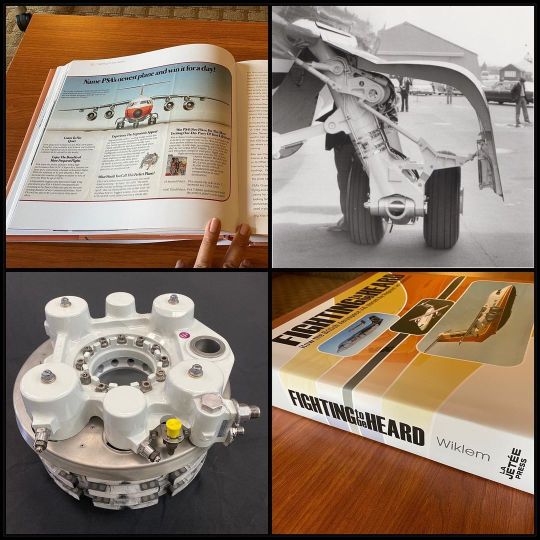
The first production commercial aircraft to use carbon brakes was Concorde, but the second production commercial aircraft to have carbon brakes was the British Aerospace BAe-146 which first flew in September 1981. Previously seen only high performance military aircraft, carbon brakes on the 146 was really the first widespread commercial aircraft use given the minuscule production numbers of Concorde. Comparing conventional steel brakes with carbon brakes for the same aircraft, carbon brakes are 40% lighter with better heat absorption. At the time of the 146’s genesis, carbon brakes are considerably more expensive than steel brakes, so it’s use on a short haul jetliner was unprecedented at the time. I’ve posted before about our new aviation publishing venture, La Jetee Press, and our inaugural book,“Fighting to be Heard: How the British Aerospace Bae-146 Started the Regional Jet Revolution” by Brian Wiklem. In the next several weeks, I’ll be talking more about the BAe-146, Brian Wiklem’s book, as well as giving you a feel for the mission and passion of La Jetee Press. Humor me the self promotion, but as a life-long avgeek, this book and our enterprise is an exciting time for me I absolutely have to share with everyone. You can order Brian’s book at www.lajeteepress.com. #avgeek #aviation #aircraft #planeporn #LaJeteePress #HawkerSiddeley #BritishAerospace #BAe #BAe146 #instaaviation #aviationlovers #flight #AvGeekSchoolofKnowledge #AvGeekNation #TeamAvGeek https://www.instagram.com/p/Ced6FSJuXaG/?igshid=NGJjMDIxMWI=
#avgeek#aviation#aircraft#planeporn#lajeteepress#hawkersiddeley#britishaerospace#bae#bae146#instaaviation#aviationlovers#flight#avgeekschoolofknowledge#avgeeknation#teamavgeek
17 notes
·
View notes
Photo

Flight testing of the first version of the spiroid winglet in 1993 resulted in refinements to the design that led to more of an squared arch design with the inboard section moved aft and outboard to bring it closer to the wingtip vortex. The refined spiroid design was flight tested on a #Dassault #Falcon50 in August 2010. The winglets and structural strengthening needed added 550 pounds to the jet. This Falcon 50 made its first public appearance at the 2010 AirVenture air show at Oskhosh. Constructed of polished aluminum and approximately six feet in height, the new spiroids not just attenuated the wingtip vortex but attempted to eliminate them. Flight testing showed that a 30% improvement over the blended winglet was potentially possible with further refinements and use of computational fluid dynamics. So why haven't spiroid winglets caught on? In aircraft design, nothing comes for free as there are always tradeoffs. Winglets in general cause an upward bending moment on the outer wings as they act like wingtip extensions that increase the effective aspect ratio of a wing. As a result, structural reinforcement is sometimes needed to offset the bending. A less capable #winglet might be more desirable as less modification is needed, like going with a blended winglet versus a spiroid. In addition, as pointed out by friend and fellow #avgeek @jonostrower, there were also challenges with icing requirements. Spiroids were just past the price point for the airlines as more structural modification would have been needed. The costs and additional weight would have offset the performance gains. All was not lost- the split scimitar winglet benefitted from the work done on the spiroid as a split scimitar can be considered sort of a spiroid with part of the loop cut out! #aviation #aircraft #planeporn #instaplane #WeirdWings #AviationPartners #instagramaviation #splendid_transport #instaaviation #aviationlovers #flight #AvgeekSchoolofKnowledge #AvGeekNation https://www.instagram.com/sentinelchicken/p/CY203Nts13P/?utm_medium=tumblr
#dassault#falcon50#winglet#avgeek#aviation#aircraft#planeporn#instaplane#weirdwings#aviationpartners#instagramaviation#splendid_transport#instaaviation#aviationlovers#flight#avgeekschoolofknowledge#avgeeknation
26 notes
·
View notes
Photo
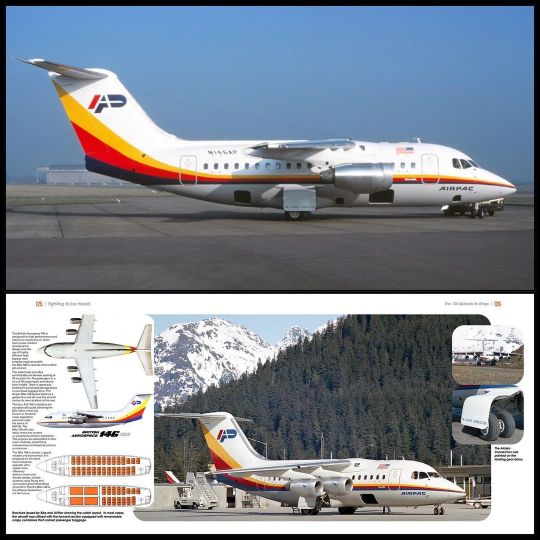
One of the more unusual BAe-146 users was AirPac, a charter #airline based in Dutch Harbor, Alaska. Established in 1978, #AirPac started with a Swearingen Metro II and a Cessna 414 on services between Dutch Harbor and Anchorage. The addition of a Fokker F27 allowed for increased cargo operations during the seafood season and extension of charter operations to other airports. Jet operations into Dutch Harbor were the next step. At the time, Dutch Harbor had a 3950' gravel runway and after much study, the #BAe146 was the best candidate and a single example was acquired. It was the first jet service at Dutch Harbor and the flying time to ANC was cut from 3:00 to 1:15. In 1984, the Alaska Transport Commission took AirPac to court for operating a supplemental base in Anchorage, a violation of its state taxi charter. Reeve Aleutian Airways filed an amicus brief, hoping to knock AirPac out as a competitor. The case went before the Alaska Supreme Court. The ATC's case was based on the 146 spending 80% of the time at ANC, all the 146 pilots lived in Anchorage, AirPac used an Anchorage telephone number and had a full time employee at ANC to handle passengers. Since AirPac was an air taxi outfit, it did not have a ticketing counter at the airport, so one of their jobs was to meet passengers and direct them to their AirPac flight. AirPac responded they had to book flights back to Dutch Harbor to be economically viable and at the time, phone service to Dutch Harbor was unreliable, so an Anchorage phone number was needed. AirPac also argued that not being allowed to market flights back to Dutch Harbor infringed in free speech. The Alaskan Supreme Court sided with AirPac. The photo is of AirPac's #BAe-146. The lettering on the main landing gear door is "The Alaska Connection". The second image is the full page on AirPac's BAe-146 from “Fighting to be Heard: How the British Aerospace Bae-146 Started the Regional Jet Revolution” by Brian Wiklem, the inaugural title from our new aviation publishing house, #LaJeteePress (www.lajeteepress.com). #avgeek #aviation #aircraft #planeporn #BritishAerospace #aviationlovers #flight #AvGeekSchoolofKnowledge https://www.instagram.com/p/CehMW9buxLL/?igshid=NGJjMDIxMWI=
#airline#airpac#bae146#bae#lajeteepress#avgeek#aviation#aircraft#planeporn#britishaerospace#aviationlovers#flight#avgeekschoolofknowledge
13 notes
·
View notes
Photo
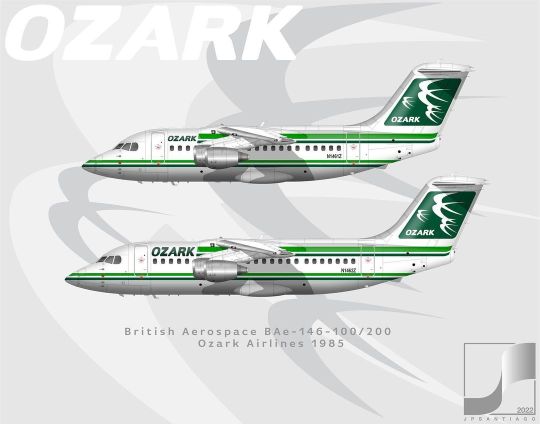
More from my aviation multiverse where the BAe-146 was used by more airlines than what happened on our timeline. This time, it's Ozark. GO GETTERS GO OZARK! In March 1972, St. Louis-based Ozark Air Lines began to use De Havilland DHC-6 Twin Otters on passenger services between Springfield, Illinois, and Chicago's lakefront Meigs Field in competition to a similar service started by the commuter airline Air Illinois. Ozark's services only lasted one year due to financial losses primarily due to high crew salaries- Ozark's pilot contract did not have provisions for proportionally lower wages for flying smaller aircraft. It was one of several attempts by local service carriers to fly smaller aircraft to smaller markets (it was also tried by West Coast/Air West, Frontier, and Texas International as well. Suppose Chicago Meigs Field became something like today's London City Airport instead of getting bulldozed in the middle of the night? Suppose Ozark's original Meigs Field services stayed viable and by the 1980s, Ozark used the quiet STOL capabilities of the BAe-146 to fly into Meigs Field? In our alternate history, Ozark would have a fleet of BAe-146s to support services direct into close-in Meigs Field from points throughout Ozark's network. Imagine that sort of Chicago- with commercial air service from O'Hare, Midway *and* Meigs! Imagine the -200s operating denser routes like STL-CGX, DCA-CGX, LGA-CGX or DTW-CGX with the smaller -100 operating thinner routes like DSM-CGX, IND-CGX, or MCI-CGX. This illustration depicts both the BAe-146-100 and BAe-146-200 as they might have looked in 1985 in Ozark's final colors before their acquisition by TWA in 1986. Learn about real world BAe-146s! www.lajeteepress.com "Fighting to be Heard: How the British Aerospace 146 Started the Regional Jet Revolution" by Brian Wiklem! GET UP AND GO! GO GETTERS GO BUY THIS BOOK! #avgeek #aviation #aircraft #planeporn #thechickenworks (follow this tag to see more of my artwork) #BritishAerospace #BAe #BAe146 #Ozark #Airlines #aviationlovers #flight #Adobe #Illustrator #aviationart #aviationillustration #IllustratorCC #Avgeekschoolofknowledge #AvGeekNation https://www.instagram.com/p/CfF5lH2LUhP/?igshid=NGJjMDIxMWI=
#avgeek#aviation#aircraft#planeporn#thechickenworks#britishaerospace#bae#bae146#ozark#airlines#aviationlovers#flight#adobe#illustrator#aviationart#aviationillustration#illustratorcc#avgeekschoolofknowledge#avgeeknation
7 notes
·
View notes
Photo

In the early 1970s at the time of the launch of the British Aerospace BAe-146 (back then still Hawker Siddeley), there was considerable interest in STOL airliners in the industry. This particular design proposal was the Boeing/Aeritalia 751, a joint venture with the Italian aircraft company Aeritalia which at the time of this STOL airliner proposal, had just been formed with the merger of Fiat Aviazone and Aerfer. Aerfer built Italy's first supersonic jet, the Saggitario. Aeritalia merged with Aermacchi in 1990 to create Alenia Aeronautica. Work on the 751 began in 1970 with 40 Aeritalia engineers assigned to Boeing Renton. Unlike the BAe-146 though, it was a larger aircraft, seating 100-150 passengers. It would have had the capability of carrying 100 passengers 500 miles using runways under 2000 feet long. The design would have used the jet augmenter wing concept, which takes the concept of blown flaps further by arranging the exit slots in a way that boosts the airflow over the wing by pulling in ambient air and augmenting the airflow over the flaps. NASA tested a jet augmenter wing STOL on a converted DHC-6 Buffalo. However, the Arab Oil embargo in 1973 and subsequent rise in fuel prices led the 751 being quietly shelved. One of the drawbacks of jet augmenter designs is the added weight of the systems needed to allow STOL performance of the wing. The short range of the 751 also lessened its commercial appeal. It wasn't all for naught, though. Working with Aeritalia proved beneficial and in 1974, Boeing and Aeritalia signed a risk-sharing agreement to work on a new widebody twin that eventually became the Boeing 767. It was a new approach for Boeing, from the start of the design process, the 767 had to have better operating costs than any other previous design. #avgeek #aviation #aircraft #planeporn #instaplane #BAESystems #BritishAerospace #BAe146 #Boeing #Aeritalia #instagramaviation #splendid_transport #instaaviation #aviationlovers #flight #AvgeekSchoolofKnowledge #AvGeekNation https://www.instagram.com/p/CfB_rsVL-0S/?igshid=NGJjMDIxMWI=
#avgeek#aviation#aircraft#planeporn#instaplane#baesystems#britishaerospace#bae146#boeing#aeritalia#instagramaviation#splendid_transport#instaaviation#aviationlovers#flight#avgeekschoolofknowledge#avgeeknation
7 notes
·
View notes
Photo

I'd already posted about the only Alaskan BAe-146 operator, AirPac, that routinely operated a 146-100 into Dutch Harbor back when its runway was still gravel. Routine rough field operations in the 146 was something envisioned from the get go in the 146 program but it was never fully realized except by niche operators. Like, only two. One was AirPac, the other was Australian operator Cobham (formerly National Jet Systems) that used its 146s to support the mining industry in Western Australia. The top part of this image is from BAe and is a striking photo of a 146-100 during rough field testing. It's likely (thanks to Brian's guidance when I asked him) G-OPSA which was LN2 and was leased to PSA for crew training. Three 146-100s flew with PSA and could be identified as the PSA cheatlines were straight across the nose whereas the 146-200s, the cheatlines curved under the nose. The lower half of this image and is from Cobham showing one of their 146-200s operating from a gravel strip at a remote mining site in Western Australia. On 4 November 2021, the final Cobham 146 flight touched down in Perth after a fly-in/fly-out charter flight to a mining site at Murrin Murrin for Minara Resources. Their mining operation at Murrin Murrin extracts nickel and cobalt. Beginning in 1990, Cobham operated a total of 33 BAe-146s in Western #Australia with some of the aircraft fitted out for rough field operations to support the Australian mining industry. At its height, Cobham had 16 146s operating in the region. Cobham has replaced the BAe-146 with the E190 and Q400 to serve the mining industry, but I'm not aware of any rough field capability for those aircraft unless the runways at the mining sites have been paved. #avgeek #aviation #aircraft #planeporn #instaplane #BAESystems #BritishAerospace #BAe146 #Cobham #NationalJetSystems #instagramaviation #splendid_transport #instaaviation #aviationlovers #aviationphotography #flight #AvGeeksAero #AvgeekSchoolofKnowledge #AvGeekNation https://www.instagram.com/p/Ce9uOM1vvh3/?igshid=NGJjMDIxMWI=
#australia#avgeek#aviation#aircraft#planeporn#instaplane#baesystems#britishaerospace#bae146#cobham#nationaljetsystems#instagramaviation#splendid_transport#instaaviation#aviationlovers#aviationphotography#flight#avgeeksaero#avgeekschoolofknowledge#avgeeknation
7 notes
·
View notes
Photo

On a Facebook aviation group a map image from around 1981-82 of the area around the old Greater Southwest International Airport was posted. I overlaid it on a current Google Earth screen shot and labeled some salient features. I didn’t move to the DFW area until 1989, so it’s kinda cool that GSW/Amon Carter Field lasted into the 1980s (even though closed) years after DFW International Airport opened in 1973. The east-west freeway is SH183 (Airport Freeway). There used to be a tunnel where it crossed under 17/35 of GSW/Amon Carter Field. Spur 459 on the upper right is International Parkway and the south entrance to DFW. The DFW Rental Car Center is visible in the upper right. Runway 17/35 is now Amon Carter Boulevard, but the very north end of 17/35 and it’s associated taxiway/hold pad you can still see when you fly into and out of DFW. If you're on the ramp going to SH360 south from SH183 westbound or coming south out of International Parkway, you can see it on your right as well. The old American Airlines HQ complex is on the west side of Amon Carter Boulevard. For years the trees that lined the GSW access road were still visible well into the early 2000s until some commercial buildings were built in the area. Satellite images of when the SE corner of 183/360 was an empty field you can see traces of Runway 13/31. The new Skyview 8 HQ complex is south of the CR Smith Museum. Skyview 3/4 are north of the Museum and American Airlines Integrated Operations Center (IOC) is Skyview 2. (For those curious, Skyview 1 is the AA Reservations Center) The ZFW ARTCC is near the CR Smith Museum as well. The rail line south of the airport perimeter is the commuter rail line now that connects downtown Fort Worth to downtown Dallas. Just to the west of where the threshold of 35 is Centerport Station for the Trinity Railway Express. #avgeek #aviation #DFW #DallasFortWorth #Texas #airport #instagramaviation #splendid_transport #instaaviation #aviationlovers #aviationphotography #flight #AvGeeksAero #AvgeekSchoolofKnowledge #AvGeekNation https://www.instagram.com/p/CeqvjLbuhG1/?igshid=NGJjMDIxMWI=
#avgeek#aviation#dfw#dallasfortworth#texas#airport#instagramaviation#splendid_transport#instaaviation#aviationlovers#aviationphotography#flight#avgeeksaero#avgeekschoolofknowledge#avgeeknation
9 notes
·
View notes
Photo

My prior post about the 1970 Boeing/Aeritalia 751 STOL airliner that would have been a contemporary of the BAe-146 mentioned that it used jet augmentor wing technology. The jet augmentor wing was more than just blown flaps like what was used on the F-104 Starfighter or the Blackburn Buccaneer. The jet efflux in the augmentor wing was channeled between a pair of flaps which was slotted to bring in ambient air and boost the air flow through the flaps. The NASA image on the right shows the flap opening on the trailing edge of the C-8A Augmentor Wing Jet research aircraft. That acted like a jet exhaust. Note also the vectored nozzle on the side of the engine nacelle that was also a feature of this research aircraft. The schematic on the right shows the engine installation and I've highlighted in blue (cool air flow) and red (hot air flow) the efflux components. A Rolls Royce Spey Mk.511 as used on the Gulfstream II/III was the basis. Bypass flow from the engine was used for the wing augmentor. Using cool bypass flow saved on the need for heat protection. The hot section exhaust was sent through two vectored nozzles based on the vectoring nozzles of the Pegasus engine used on the Harrier. Because the role of the aircraft was to study low speed handling, the landing gear and forward slats were fixed and the augmentor flap was deflectable but not fully retractable. Cross bleed air was used to maintain flow the augmentor flaps in the event of a single engine failure. Some asymmetric lift still occurred but could be countered by differential nozzle deflection. This testbed flow in the early 1970s and one outcome of the joint research work between Canada and NASA was that jet augmentor wing aircraft were loud which would have limited their commercial appeal. Noise was something that was a concern during the design of the BAe-146 as well as other proposed STOL airliners of the early 1970s. #avgeek #aviation #aircraft #planeporn #instaplane #NASA #Canada #DHC5 #Buffalo #C8 #DeHavillandCanada #RollsRoyce #instagramaviation #splendid_transport #instaaviation #aviationlovers #flight #AvgeekSchoolofKnowledge #AvGeekNation https://www.instagram.com/p/CfCoBOEPB6v/?igshid=NGJjMDIxMWI=
#avgeek#aviation#aircraft#planeporn#instaplane#nasa#canada#dhc5#buffalo#c8#dehavillandcanada#rollsroyce#instagramaviation#splendid_transport#instaaviation#aviationlovers#flight#avgeekschoolofknowledge#avgeeknation
4 notes
·
View notes
Photo
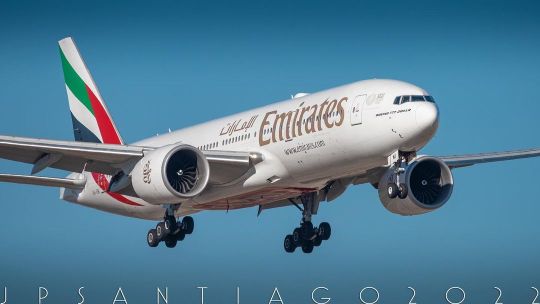
Emirates 221 Heavy nears the end of its 14.5 hour flight from DXB to DFW. You can clearly see the complex-shaped swept blades on the fan of the massive GE90-110B1 engines. When the second generation of GE90 engines for the 777-300ER and 777-200LR were under development, GE looked using conventional "radial" blades like that used on the GE90-94B used on the 777-200(ER), but using advanced computational fluid modeling techniques, found that the complex-shaped swept blades were more efficient and increased the air mass flow through the engine. This translates into a thrust gain of 1000-2000 lbs *just* from the fan blade shape- that excludes the improvements made to the GE90 core. #Avgeek #aviation #aircraft #planeporn #DFW #dfwavgeek #airport #planespotting #Boeing #777 #A6EWI #Emirates #Airlines #instagramaviation #splendid_transport #aviationlovers #aviationphotography #flight #AvGeeksAero #AvgeekSchoolofKnowledge #AvGeekNation #TeamAvGeek (at DFW Airport) https://www.instagram.com/p/Cgp4gd3sgZR/?igshid=NGJjMDIxMWI=
#avgeek#aviation#aircraft#planeporn#dfw#dfwavgeek#airport#planespotting#boeing#777#a6ewi#emirates#airlines#instagramaviation#splendid_transport#aviationlovers#aviationphotography#flight#avgeeksaero#avgeekschoolofknowledge#avgeeknation#teamavgeek
4 notes
·
View notes
Photo

This is McDonnell Douglas artwork showing the MD-12X as it appeared in late 1991 during the design phase. While it looks much like the MD-11, it's clear that it's longer, the engines are larger and the note the wings are bigger with canoe-shaped flap actuator/track fairings instead of the characteristic external flap hinge fins used on the MD-11. On 25 October 1991, the McDonnell Douglas board of directors gave formal approval to start offering the MD-12X to prospective airline customers. Canted winglets based on those used on the MD-11 would appear on again, off again during this time period. Official renderings did not have them as it was felt the wingspan increase and larger wing would make them unnecessary by late 1991, but wind tunnel models from earlier in the year show winglets present. It was becoming rapidly apparent to McDonnell Douglas through 1991 that the MD-12X would not meet its range and payload targets using the same engines and wing as the MD-11. With a larger wing and engines came the opportunity for capacity increases- but further stretches of the fuselage would have left the MD-12X design longer than what would have been compatible than existing airport gate infrastructure which was sized around an aircraft the size of the 747-400. By the spring of 1992, the MD-12X would morph into a four engine double deck airliner marketed as the MD-12. #McDonnellDouglas #MD12 #MD12X #MD11 #Boeing #instagramaviation #splendid_transport #instaaviation #aviationlovers #aviationphotography #flight #AvGeeksAero #AvgeekSchoolofKnowledge #AvGeekNation https://www.instagram.com/sentinelchicken/p/CYDaod6rT4O/?utm_medium=tumblr
#mcdonnelldouglas#md12#md12x#md11#boeing#instagramaviation#splendid_transport#instaaviation#aviationlovers#aviationphotography#flight#avgeeksaero#avgeekschoolofknowledge#avgeeknation
8 notes
·
View notes
Photo
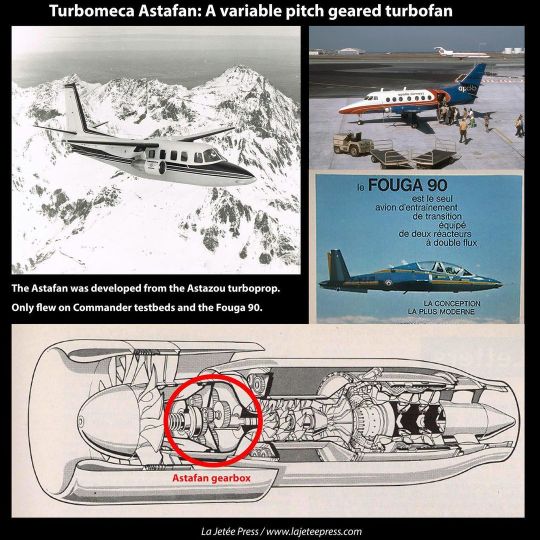
Before we move on in our survey of geared turbofans that will bring us to the Lycoming ALF 502 of the BAe-146 and the new PW1000G, let’s take a side trip from the Turbomeca Aubsique engine to another Turbomeca geared turbofan that did not reach production, the Astafan. I previously posted that the canceled Aerospatiale A.904 STOL airliner was to use a variable pitch geared turbofan called the M45SD that was based on the M45 engine used on the VFW614 airliner. A variable pitch front fan is exceedingly rare in jet engine technology- the M45SD was bench tested but never flew. But the Astafan did fly. On two different aircraft. The Astafan was based on the Astazou turboprop which was used on many aircraft of the 1960s and 1970s but most notably on the early versions of the Handley Page (later BAe) Jetstream. The Astazou first flew in 1957 and was used in both turboprop and turboshaft applications. It was easy to fit a gearbox to the Astazou core sized for the variable pitch front fan to create the Astafan. On the lower schematic, I’ve highlighted the location of the Astafan’s gearbox. Turbomeca tested the engine on two Rockwell Twin Commanders that had the piston engines removed but fairings for the main landing gears. The Astafan engines were slung underwing from pylons. Compared to turbojets of similar size, the Astafan was quieter and more fuel efficient. It first ran in 1969 but never reached production. The machinery for both the front fan gearbox and the variable pitch fan made the engine heavier than comparable designs and there were concerns about the complexity of maintenance. The only other aircraft to fly with the Astafan was the Fouga 90 which was planned as a modern successor to the Magister jet trainer. First flying in 1978, the Alpha Jet was selected instead of the Fouga 90 for the Armee de l’Air’s jet training requirements. Only a single Fouga 90 was built. (Jetstream photo: Richard Silagi) #avgeek #aviation #aircraft #planeporn #LaJeteePress #Turbomeca #Astafan #Astazou #turboprop #Jetstream #Aerospatiale #Fouga #Safran #instaaviation #aviationlovers #flight #AvGeekSchoolofKnowledge #AvGeekNation #TeamAvGeek https://www.instagram.com/p/Cfre_oiuOyP/?igshid=NGJjMDIxMWI=
#avgeek#aviation#aircraft#planeporn#lajeteepress#turbomeca#astafan#astazou#turboprop#jetstream#aerospatiale#fouga#safran#instaaviation#aviationlovers#flight#avgeekschoolofknowledge#avgeeknation#teamavgeek
2 notes
·
View notes